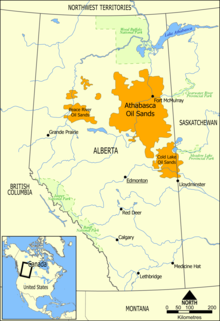Athabasca oil sands
| Athabasca oil sands | |
|---|---|
 |
|
| Country | Canada |
| Region | Northern Alberta |
| Offshore/onshore | Onshore, mining |
| Coordinates | 57°01′N 111°39′W / 57.02°N 111.65°WCoordinates: 57°01′N 111°39′W / 57.02°N 111.65°W |
| Operators | Syncrude, Suncor, CNRL, Shell, Total, Imperial Oil, Petro Canada, Devon, Husky, Statoil, Nexen |
| Partners | Chevron, Marathon, ConocoPhillips, BP, Oxy |
| Field history | |
| Discovery | 1848 |
| Start of production | 1967 |
| Production | |
| Current production of oil | 1,300,000 barrels per day (~6.5×107 t/a) |
| Estimated oil in place | 133,000 million barrels (~1.81×1010 t) |
| Producing formations | McMurray, Clearwater, Grand Rapids |
The Athabasca oil sands or (tar sands) are large deposits of bitumen or extremely heavy crude oil, located in northeastern Alberta, Canada – roughly centred on the boomtown of Fort McMurray. These oil sands, hosted primarily in the McMurray Formation, consist of a mixture of crude bitumen (a semi-solid rock-like form of crude oil), silica sand, clay minerals, and water. The Athabasca deposit is the largest known reservoir of crude bitumen in the world and the largest of three major oil sands deposits in Alberta, along with the nearby Peace River and Cold Lake deposits (the latter stretching into Saskatchewan).
Together, these oil sand deposits lie under 141,000 square kilometres (54,000 sq mi) of boreal forest and muskeg (peat bogs) and contain about 1.7 trillion barrels (270×109 m3) of bitumen in-place, comparable in magnitude to the world's total proven reserves of conventional petroleum. The International Energy Agency (IEA) lists the economically recoverable reserves, at 2006 prices and modern unconventional oil production technology, to be 178 billion barrels (28.3×109 m3), or about 10% of these deposits. These contribute to Canada's total proven reserves being the third largest in the world, after Saudi Arabia and Venezuela's Orinoco Belt.
By 2009, the two extraction methods used were in situ extraction, when the bitumen occurs deeper within the ground, (which will account for 80 percent of oil sands development) and surface or open-pit mining, when the bitumen is closer to the surface. Only 20 percent of bitumen can be extracted using open pit mining methods, which involves large scale excavation of the land with huge hydraulic power shovels and 400-ton heavy hauler trucks. Surface mining leaves toxic tailings ponds. In contrast, in situ uses more specialized techniques such as steam-assisted gravity drainage (SAGD). "Eighty percent of the oil sands will be developed in situ which accounts for 97.5 percent of the total surface area of the oil sands region in Alberta." In 2006 the Athabasca deposit was the only large oil sands reservoir in the world which was suitable for large-scale surface mining, although most of this reservoir can only be produced using more recently developed in-situ technology.
...
Wikipedia
